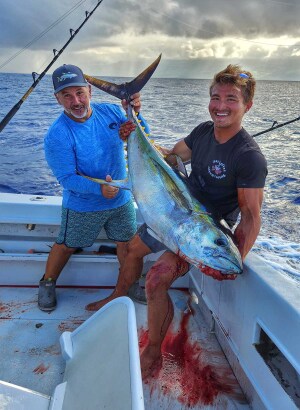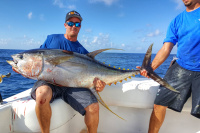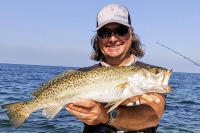Yellowfin tuna, a large, pelagic fish, inhabits warm Atlantic, Indian, and Pacific oceans. They are apex predators, consuming small fish, squid, and crustaceans. Highly migratory, they spawn in tropical waters and migrate to cooler, nutrient-rich waters for breeding. Yellowfin tuna are valuable for sport fishermen and are an essential part of the marine ecosystem.
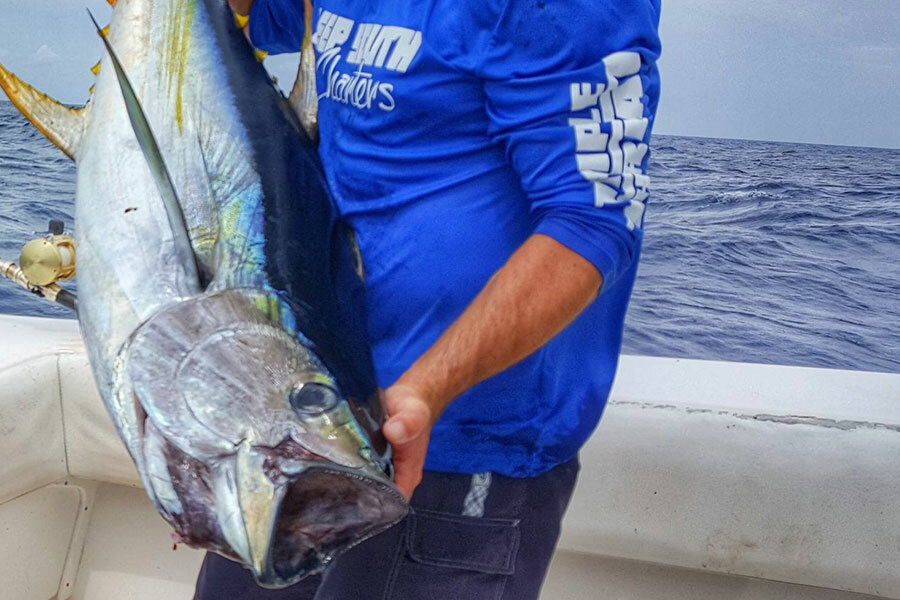
Effective Offshore Fishing Techniques for Yellowfin Tuna
Yellowfin tuna are remarkable creatures with a wide range of adaptations that allow them to thrive in the open ocean. Their streamlined bodies and powerful muscles enable them to swim at incredible speeds, making them one of the fastest fish in the sea. This speed is crucial for catching prey and evading predators.
The yellowfin tuna's distinctive coloration, with a dark blue back and yellow sides, serves as a form of countershading camouflage. When viewed from above, the dark back blends in with the deep blue of the ocean, while the yellow sides blend in with the bright sunlight filtering through the water when viewed from below. This adaptation helps them to avoid detection by both prey and predators.
As apex predators, yellowfin tuna play a crucial role in maintaining the balance of marine ecosystems. They help to control the populations of smaller fish and squid, preventing them from overgrazing on lower trophic levels. This top-down control helps to maintain the diversity and stability of marine communities.
The migration patterns of yellowfin tuna are influenced by a variety of factors, including water temperature, currents, and the availability of food. They are known to follow warm water currents and congregate around underwater structures such as seamounts and ridges, where upwelling currents bring nutrient-rich water to the surface and support high levels of biological productivity.
Yellowfin tuna are not only important ecologically, but also economically. They are highly valued as a food fish and are widely consumed around the world. The meat is prized for its firm texture and mild flavor, and is often used in sushi and sashimi. The global demand for yellowfin tuna has led to concerns about overfishing and the sustainability of tuna populations, and many countries have implemented strict fishing regulations to help protect these important fish.
For in-depth instruction from several expert yellowfin tuna fishermen, watch our Tuna Fishing Videos.
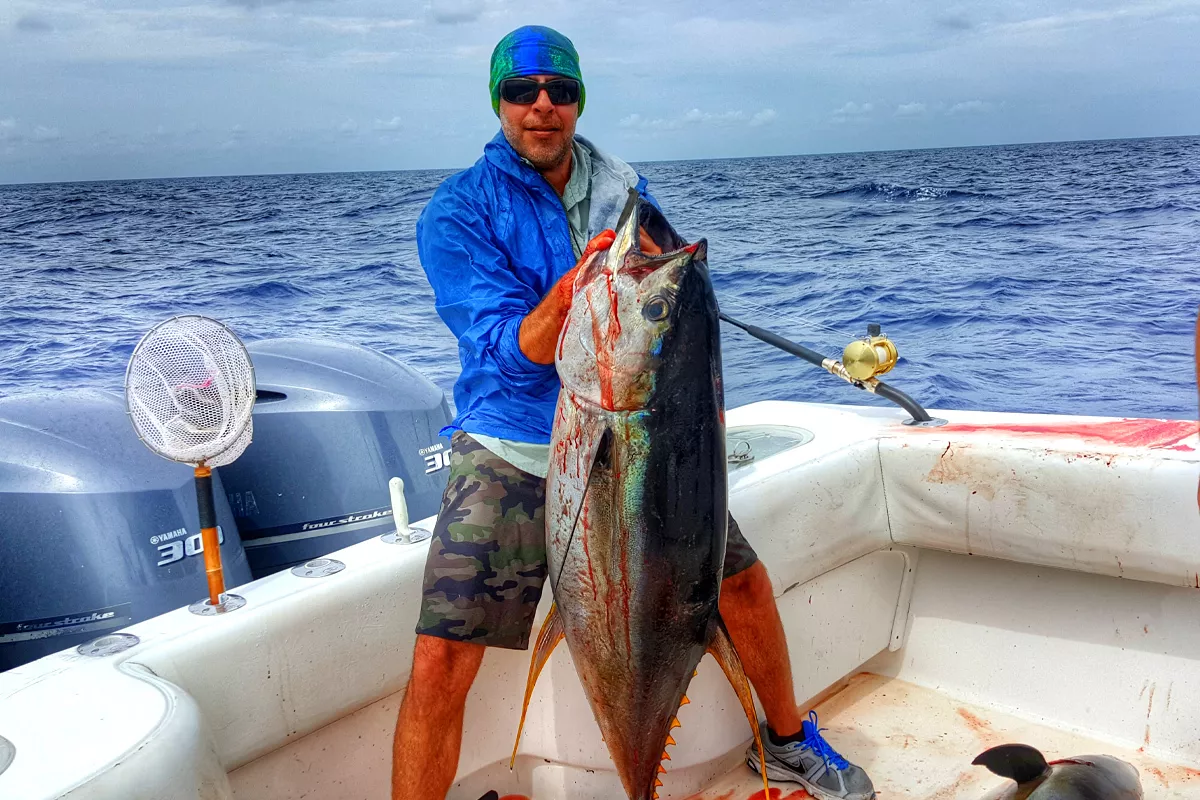
Primary Characteristics
Colorartion: The coloration of yellowfin tuna is an adaptation that provides camouflage in their open ocean habitat. The dark blue back blends in with the deep blue water when viewed from above, while the silvery sides and belly blend in with the bright, filtered sunlight when viewed from below. This countershading helps them avoid detection by both predators and prey. The yellow finlets and finlets with black edges are also believed to aid in camouflage, breaking up the outline of the fish and making it harder to spot.
Mouth: The mouth of the yellowfin tuna is well-adapted for capturing and consuming prey. The small, sharp teeth and fleshy papillae lining the mouth help grip and swallow prey items whole. The lingual teeth on the tongue and highly developed gill rakers also aid in moving food towards the esophagus and extracting oxygen from the water, respectively. These adaptations allow yellowfin tuna to efficiently capture and consume a wide variety of prey items, from small fish and squid to larger pelagic species.
Speed:The speed and agility of yellowfin tuna are remarkable, with short bursts of up to 50 miles per hour (80 kilometers per hour) and sustained speeds of around 25-30 miles per hour (40-48 kilometers per hour). This incredible swimming ability is made possible by their streamlined body shape, powerful musculature, and unique tail structure. The crescent-shaped or sickle-shaped tail, with its deeply forked shape and larger lower lobe, provides the thrust and maneuverability needed to reach such high speeds and maintain them for extended periods.
Tail: The tail structure of yellowfin tuna is called a crescent-shaped or sickle-shaped tail, which is an adaptation that allows them to swim quickly and efficiently for extended periods. The tail fin, or caudal fin, is deeply forked, and the lower lobe is much larger than the upper lobe. This unique tail structure is what gives them the ability to swim at high speeds and with great agility, allowing them to chase down prey and escape predators.
The combination of coloration, size, mouth structure, speed, and tail shape make yellowfin tuna one of the most well-adapted and successful predators in the open ocean. These adaptations have allowed them to thrive in a wide range of habitats and play a crucial role in the structure and function of marine ecosystems. However, their popularity as a food fish and the increasing pressure from commercial fishing operations have led to concerns about the sustainability of yellowfin tuna populations. Effective management and conservation efforts are necessary to ensure that these magnificent fish continue to play their vital role in the world's oceans.
Distinguishing Features of Yellowfin Tuna From Other Fish
- Coloration: Yellowfin tuna have a metallic blue-black back and yellow sides and finlets, which distinguishes them from other tuna species that have different coloration patterns.
- Finlets: Yellowfin tuna have bright yellow finlets, which are small fins on the top and bottom of their body behind the dorsal and anal fins.
- Pectoral fins: Yellowfin tuna have long, sickle-shaped pectoral fins that are longer than other tuna species, such as albacore and skipjack tuna.
- Size: Yellowfin tuna are generally larger than other tuna species, with adult yellowfin tuna averaging 100-200 pounds, although they can grow up to 400 pounds or more.
- Eye size: Yellowfin tuna have large eyes relative to their body size, which is an adaptation for hunting prey in deep water and low light conditions.
- Behavior: Yellowfin tuna are highly migratory, and often travel in large schools that can cover hundreds of miles in a short period of time. They are also known for their high-speed swimming and acrobatic jumps out of the water.
- Finlets rays: Yellowfin tuna have 7-10 finlets on both their dorsal and ventral sides, which have 13-16 rays. This distinguishes them from other tuna species that have fewer finlets and rays.
- Body shape: Yellowfin tuna have a streamlined body shape that is designed for fast swimming in open water, with a narrow head and tapered body that reduces drag and increases speed.
Overall, yellowfin tuna are a highly distinctive species that can be easily recognized by their unique coloration, long pectoral fins, and bright yellow finlets. Their large size, high-speed swimming, and highly migratory behavior make them an iconic and highly sought-after gamefish for anglers around the world.
Habitat
Yellowfin tuna inhabit warm and tropical waters throughout the world's oceans, typically within 20 degrees north and south of the equator. They are a pelagic species, meaning they inhabit the open ocean and not near the seabed. They are often found in offshore waters, near the surface or in the upper part of the water column, but they can also dive to depths of up to 1,000 meters (3,280 feet) in search of prey.
Yellowfin tuna prefer to inhabit areas with a mix of warm and cool water currents that support a diverse range of baitfish species, such as flying fish, squid, and mackerel. They are often associated with floating objects, such as logs or seaweed, which provide shelter for baitfish and attract larger predatory fish. Yellowfin tuna also frequently congregate around natural features such as seamounts, underwater ridges, and drop-offs, where currents and upwellings bring nutrients and baitfish to the surface.
They are a highly migratory species, and their movements are influenced by water temperature, currents, and prey availability. Yellowfin tuna migrate long distances, with some individuals known to travel over 5,000 kilometers (3,100 miles) in a single year. They are known to undertake transoceanic migrations, and can be found in waters around the world, including the Atlantic, Indian, and Pacific Oceans.
Distribution
Yellowfin tuna have a wide distribution in tropical and subtropical oceans around the world. They are found in the Atlantic, Indian, and Pacific Oceans, typically in waters with temperatures ranging from 20-30°C (68-86°F). They tend to prefer offshore waters, but can also be found in coastal areas, particularly around islands and seamounts. The largest populations of yellowfin tuna are found in the western and central Pacific Ocean, particularly in the waters around Indonesia, the Philippines, and Papua New Guinea. They are also found in large numbers in the eastern Pacific off the coasts of Mexico, Central America, and South America. In the Atlantic Ocean, they are found in the western and central parts, particularly around the Gulf of Mexico, the Caribbean, and West Africa. In the Indian Ocean, they are found in the western and central parts, particularly around the Seychelles, Mauritius, and Madagascar.
Thunnus albacares Diet
Yellowfin tuna are indeed opportunistic predators with a varied diet that depends on the availability of prey in their local environment. Their feeding habits are influenced by factors such as the time of day, water temperature, and the presence of other marine life.
During the day, yellowfin tuna often feed near the surface, where they can take advantage of the abundant small fish and squid that are attracted to the sunlight. Anchovies, sardines, and mackerel are common prey items in this upper part of the water column. These small fish form dense schools, which yellowfin tuna can easily target and consume in large numbers. The tuna's speed and agility allow them to chase down and capture these fast-moving prey items.
At night, yellowfin tuna often dive to deeper depths to feed on organisms that migrate vertically in the water column. Many species of squid, crustaceans, and small fish move up from the depths at night to feed on plankton near the surface. As these organisms return to deeper water at dawn, yellowfin tuna follow them, feeding on them in the darker, deeper parts of their habitat. The tuna's large eyes and keen vision allow them to locate and capture prey even in low-light conditions.
Yellowfin tuna are also known to congregate around floating objects, such as logs, buoys, or even garbage, which can attract small fish seeking shelter. These floating objects create mini-ecosystems, providing a food source for smaller fish, which in turn attract larger predators like yellowfin tuna. By feeding in these areas, yellowfin tuna can take advantage of the concentration of prey and conserve energy that would otherwise be spent searching for food.
In addition to these feeding strategies, yellowfin tuna are also known to work together in groups to herd and capture prey. By coordinating their movements, they can corral schools of small fish into tightly packed groups, making them easier to catch. This cooperative hunting behavior is an adaptation that allows yellowfin tuna to maximize their feeding efficiency and take advantage of a wider range of prey items.
The adaptable and opportunistic feeding habits of yellowfin tuna have allowed them to thrive in a wide range of ocean habitats. However, their reliance on specific prey items and feeding areas also makes them vulnerable to changes in ocean conditions and prey availability. As climate change and other human impacts continue to alter marine ecosystems, it will be important to monitor and protect the food sources and habitats that yellowfin tuna depend on for their survival.
When and Where to Fish for Yellows
Yellowfin tuna are found in tropical and subtropical waters around the world, with a distribution that spans across the Atlantic, Pacific, and Indian Oceans. Their wide distribution is a result of their highly migratory nature and their ability to adapt to a range of water temperatures and conditions.
In the Gulf of Mexico, yellowfin tuna are a popular target for recreational and commercial fishermen. The warm, nutrient-rich waters of the Gulf provide an ideal habitat for yellowfin tuna, particularly during the late summer and fall months when they are feeding heavily in preparation for winter. During this time, the tuna are often found near the edge of the continental shelf, where they can take advantage of the abundant baitfish and favorable water conditions. Venice, Louisiana is a particularly popular destination for yellowfin tuna fishing in the Gulf, thanks to its proximity to deep water and the abundance of baitfish in the area.
In the Eastern Pacific, yellowfin tuna can be found in the waters off the coast of Mexico, Central America, and South America. The peak fishing seasons vary depending on the specific location, with the best times to fish for yellowfin tuna typically coinciding with the local rainy seasons. In Mexico, the peak season is usually from May to October, while in Costa Rica and Panama, the best fishing is often from December to April. These seasonal variations are related to changes in water temperature, currents, and the availability of baitfish.
In the Western Pacific, yellowfin tuna are found in the waters around Hawaii, Australia, and other Pacific islands. In Hawaii, the peak fishing season is typically from May to September, when the waters are warmest and the tuna are most active. In Australia, the best fishing for yellowfin tuna is often from late autumn to early spring, when the water temperatures are cooler and the fish are more concentrated.
Regardless of the specific location, one of the keys to successful yellowfin tuna fishing is to locate areas with high concentrations of baitfish. Yellowfin tuna are opportunistic feeders and will often congregate in areas where there is an abundance of smaller fish to prey upon. This can be near underwater structures like oil rigs or floating debris, which provide shelter and attract baitfish. Areas with strong currents can also be productive, as the moving water can concentrate baitfish and attract larger predators like yellowfin tuna.
When it comes to fishing techniques, there are several effective methods for catching yellowfin tuna. Trolling with lures or bait is a popular technique, as it allows anglers to cover a large area and locate schools of tuna. Casting jigs or live bait can also be effective, particularly when the tuna are actively feeding near the surface. Chunking, or fishing with dead bait, is another technique that can be used to attract yellowfin tuna and entice them to bite.
Overall, understanding the migratory patterns, habitat preferences, and feeding behaviors of yellowfin tuna is essential for successful fishing. By targeting the right locations at the right times and using effective fishing techniques, anglers can increase their chances of landing one of these highly prized game fish. However, it is also important to fish responsibly and follow local regulations to help ensure the long-term sustainability of yellowfin tuna populations.
Effective Fishing Tips
- Locate Schools: Yellowfin tuna often school in open water or near underwater structures such as reefs or seamounts. Use your sonar to locate schools of yellowfin tuna, and then drop a line.
- Use Live Bait: Yellowfin tuna are predatory fish that feed on smaller fish, squid, and crustaceans. Using live bait such as pilchards, sardines, or small tuna can be very effective in attracting yellowfin tuna.
- Try Chunking and Chumming: Chunking and chumming are two popular techniques used to attract yellowfin tuna. Chunking involves cutting up fresh bait and tossing it overboard to create a scent trail that attracts tuna. Chumming involves using a chum bag to create a steady stream of bait particles to attract tuna to the boat.
- Experiment with Lure Types: Yellowfin tuna can be caught with a variety of lures including poppers, stickbaits, and jigs. Experiment with different types of lures to see what works best in the area you are fishing.
- Watch for Surface Activity: When yellowfin tuna are feeding on the surface, they create a lot of commotion. Look for birds diving, fish jumping, or splashes on the water's surface. These are all signs that yellowfin tuna are active in the area.
- Use the Right Gear: Yellowfin tuna are powerful fish that require specialized gear to catch. Use a heavy-duty rod and reel with a strong drag system to handle the power of these fish. Use braided line for added strength and sensitivity.
- Be Patient: Yellowfin tuna fishing can require a lot of patience. Be prepared to spend hours on the water waiting for the right opportunity to present itself. Don't give up, and be ready to act quickly when a bite occurs.
By following these tips, you can increase your chances of catching yellowfin tuna on your next fishing trip. Remember to always follow local fishing regulations and practice responsible fishing practices to help conserve this valuable resource for future generations.
Yellowfin Tuna Demand Purpose Built Fishing Gear
Using high-quality rods, reels, baits, and lures is crucial when fishing for yellowfin tuna, as these powerful fish demand the best equipment to ensure a successful catch. Yellowfin tuna are known for their incredible strength, speed, and endurance, often pushing fishing gear to its limits during intense battles. Investing in well-constructed, durable rods and reels designed to withstand the immense pressure and stress of fighting these fish is essential to prevent gear failure and lost opportunities. Additionally, selecting top-quality baits and lures that closely mimic the appearance and movement of yellowfin tuna's natural prey will increase the chances of attracting strikes and hooking up with these formidable opponents. By using the best equipment available, anglers can confidently approach yellowfin tuna fishing, knowing they have the tools necessary to effectively target and land these impressive game fish.
Reels for Yellowfin
When it comes to yellowfin tuna fishing, selecting the right rods and reels is crucial for success. As you mentioned, there are several factors to consider, such as the size of the fish, the fishing techniques, and personal preferences. Let's dive deeper into each of these aspects.
For smaller yellowfin tuna or lighter tackle fishing, a fast action rod with a light to medium power rating is indeed a good choice. Fast action rods are more sensitive and allow for quick, precise casts, which is essential when targeting speedy tuna. Light to medium power rods provide the right balance of flexibility and strength to handle the fight without overpowering the fish.
When targeting larger yellowfin tuna or using heavier tackle, a rod with a heavy power rating and a moderate to fast action is more suitable. The heavy power rating ensures that the rod has enough backbone to withstand the powerful runs and fights of bigger tuna. A moderate to fast action still allows for good sensitivity and responsiveness, which is important for detecting bites and setting the hook.
Traditionally, conventional reels were the preferred choice for yellowfin tuna fishing due to their larger line capacity and strong drag systems. These reels are designed to handle the immense power and speed of yellowfin tuna, which are known for their long, fast runs. A high-speed retrieve is also crucial for keeping up with the fish and maintaining proper line tension.
However, in recent years, heavy-duty spinning reels have gained popularity among tuna anglers. Advances in technology have led to the development of spinning reels with larger line capacities, stronger drag systems, and improved durability. These reels offer several advantages over conventional reels, such as easier casting, less line twist, and more comfortable ergonomics.
When choosing between conventional and spinning reels for yellowfin tuna fishing, consider your personal preferences and fishing style. If you prefer the traditional feel and greater control of conventional reels, they are still an excellent choice. However, if you value the ease of use and versatility of spinning reels, a high-quality, heavy-duty spinning reel can be equally effective.
Regardless of the type of reel you choose, it's essential to select a model with a high line capacity, a powerful and smooth drag system, and a fast retrieve ratio. Some popular conventional reel choices for yellowfin tuna include the Shimano Tiagra, Penn International, and Accurate BX series. For spinning reels, options like the Shimano Saragosa, Penn Slammer III, and Daiwa Saltiga are well-suited for tuna fishing.
Ensuring that your rod and reel are well-matched and balanced is crucial for optimal performance. The reel should be appropriately sized for the rod's power and action, and the line capacity should be sufficient for the size of the fish you're targeting. A well-balanced setup will feel more comfortable to use, allow for better casting and retrieving, and ultimately increase your chances of landing a yellowfin tuna.
In summary, when selecting rods and reels for yellowfin tuna fishing, consider the size of the fish, your preferred fishing techniques, and your personal preferences. Choose a rod with the appropriate power and action for the situation, and pair it with a high-quality reel that offers ample line capacity, a strong drag system, and a fast retrieve. Whether you opt for a conventional or spinning reel, ensuring a well-balanced setup will enhance your overall fishing experience and success on the water.
Use Quality Baits
When it comes to selecting the best baits for yellowfin tuna fishing, it's essential to consider factors such as the size and feeding habits of the tuna in the area, as well as the season and location. Yellowfin tuna are opportunistic feeders and will readily target a variety of live and dead baits.
Live baits are often the top choice for many yellowfin tuna anglers, as they provide a natural presentation and can be highly effective in enticing strikes. Some of the most popular live baits include:
- Hardtail (blue runner): These strong swimmers are a favorite among tuna and are commonly found in tropical and subtropical waters.
- Scad (goggle eye): Scad are known for their durability and are a popular choice for slow-trolling or drifting.
- Pilchards (sardines): These small, shiny baitfish are abundant in many coastal waters and are a primary food source for yellowfin tuna.
- Poagies (menhaden): These oily, nutrient-rich baitfish are highly attractive to tuna and are often used in chumming strategies.
- Anchovies and mackerel: Both anchovies and mackerel are common in many offshore waters and can be effective live baits for yellowfin tuna.
When using live bait, it's crucial to match the size of the bait to the size of the tuna you're targeting. Larger tuna will typically prefer bigger baits, while smaller tuna may be more attracted to smaller offerings. It's also important to rig the live bait properly to ensure a natural presentation and reduce the risk of the bait coming off the hook during the fight.
Dead baits can also be highly effective for yellowfin tuna fishing, particularly when used in combination with live baits to create a scent trail and visual attraction. Some of the most popular dead baits include:
- Squid: Squid is a versatile bait that can be used whole or cut into strips. It is particularly effective when drifted or slow-trolled.
- Ballyhoo: These elongated baitfish are commonly used in trolling and are known for their attractive swimming action.
- Bonito: Cut bonito strips can be a great addition to your bait spread, as they are oily and create a strong scent trail.
- Herring and sardines: These small, oily baitfish can be used whole or cut into chunks and are effective for both chumming and baiting.
- Menhaden: Similar to poagies, menhaden are nutrient-rich and can be used as cut bait or in chumming strategies.
When selecting dead baits, consider factors such as the bait's size, shape, and swimming action. Some baits, like ballyhoo, are preferred for their natural swimming motion, while others, like squid or cut bonito, are favored for their scent-dispersing qualities.
It's also worth noting that the preferred bait can change depending on the season and location. In some areas, yellowfin tuna may favor "green water" baits, which are typically found closer to shore, while in other regions, they may prefer "blue water" baits that are more commonly found in deeper, offshore waters.
Ultimately, the key to success when baiting for yellowfin tuna is to be adaptable and willing to experiment with different baits and presentations until you find what works best in your specific situation. By considering factors such as the size and feeding habits of the tuna, the season and location, and the properties of various live and dead baits, you can optimize your bait selection and increase your chances of landing these incredible game fish.
Yellows Respond Well to Artificial Baits
When it comes to selecting the best lures for yellowfin tuna fishing, there are several effective options, each with its own unique properties and advantages. The most popular lure types for targeting yellowfin tuna include jigs, poppers, and stickbaits.
Jigs are a versatile and highly effective option for yellowfin tuna fishing. These lures are designed to mimic the appearance and movement of small baitfish, making them irresistible to hungry tuna. When selecting jigs, it's important to match the color and size to the baitfish in the area. Some of the most recommended jig colors for yellowfin tuna include:
- Blue: Blue jigs are a popular choice, as they closely resemble many of the small baitfish that yellowfin tuna prey upon.
- Silver: Silver jigs are effective in mimicking the reflective scales of baitfish and can be particularly useful in bright, sunny conditions.
- Green: Green jigs can be a good choice when fishing in areas with a lot of underwater vegetation or when targeting tuna that are feeding on small, green-colored baitfish.
To further enhance the effectiveness of jigs, anglers often rig them with skirts or soft plastic bodies. These additions can help to more closely mimic the appearance and movement of real baitfish, increasing the chances of a strike.
Poppers are another highly effective lure choice for yellowfin tuna, particularly when the fish are actively feeding on the surface. These lures are designed to create a popping sound and splash when retrieved, which can attract the attention of tuna from a considerable distance. Some popular popper brands for yellowfin tuna fishing include:
- Williamson Jet Popper: This lure is known for its long-casting abilities and loud, attention-grabbing popping action.
- Yo-Zuri Surface Bull: This popper features a cupped face that creates a strong splashing action, making it an excellent choice for surface-feeding tuna.
- Nomad Design Chug Norris: This popper is designed to create a loud chugging sound and strong bubble trail, which can be highly effective in attracting yellowfin tuna.
Stickbaits, also known as jerkbaits or topwater lures, are another popular option for yellowfin tuna fishing. These lures are designed to mimic the appearance and swimming action of a wounded or distressed baitfish. When retrieved in a zig-zag motion across the surface of the water, stickbaits can be incredibly effective in enticing strikes from yellowfin tuna. Some highly recommended stickbaits for tuna fishing include:
- Shimano Orca Stickbait: This lure is known for its realistic swimming action and durable construction, making it a favorite among tuna anglers.
- Nomad Design Madscad Stickbait: This lure features a unique shape and weight distribution that allows for long casts and a highly attractive swimming action.
- Heru, SaltyWater Tackle, Tackle House, Siren, Jack Fin and Amegari stickbaits: These are all highly regarded stickbaits by experienced yellowfin tuna anglers. These brands are known for producing high-quality, durable lures that closely mimic the appearance and swimming action of real baitfish
Ultimately, the choice of lure will depend on the specific conditions you're fishing in and your personal preferences as an angler. It's often a good idea to carry a variety of lures in different colors, sizes, and styles to allow for adaptability on the water. By selecting high-quality lures from reputable brands and matching them to the conditions and baitfish in your area, you can greatly increase your chances of success when targeting yellowfin tuna.
Ways to Catch Yellowfin Tuna
Yellowfin tuna are highly prized game fish, and anglers employ various fishing methods and techniques to target these powerful predators. Each method has its own unique advantages and can be effective under the right conditions.
- Trolling is perhaps the most popular and widely used method for targeting yellowfin tuna. This technique involves pulling a spread of lures or baits behind a moving boat, covering a large area of water and increasing the chances of encountering tuna. Anglers can adjust the boat's speed, the type and size of lures, and the depth at which they are fished to optimize their presentation for the specific conditions and tuna behavior. Trolling allows for the use of a wide variety of lures, such as skirted ballyhoo, diving plugs, and jet heads, which can be effective in attracting strikes from yellowfin tuna.
- Chunking is another effective method, particularly when yellowfin tuna are not actively feeding on the surface. This technique involves cutting baitfish into small pieces and dispersing them into the water to create a scent trail or "chum slick." The scent of the baitfish attracts yellowfin tuna, drawing them closer to the boat and encouraging them to feed. Anglers then present baits, such as whole or cut fish, at various depths within the chum slick to entice strikes. Chunking can be particularly effective when tuna are holding deeper in the water column or when they are not responding to other methods.
- Jigging is a more active and engaging technique that can be highly effective for catching yellowfin tuna. This method involves dropping a heavy metal jig, often designed to mimic the appearance and movement of squid or baitfish, to the desired depth and then actively working the jig by jerking the rod tip up and down. The erratic, vertical motion of the jig can trigger aggressive strikes from yellowfin tuna, particularly when they are feeding on squid or other deep-water prey. Jigging allows anglers to cover different depths and water columns, making it a versatile method for targeting tuna in various situations.
- Casting is another exciting and interactive method that can be highly productive when yellowfin tuna are actively feeding on the surface. Anglers cast lures, such as poppers, stickbaits, or surface plugs, to the feeding fish and work them back to the boat using a variety of retrieves. This method allows for precise presentation and can be incredibly exciting, as anglers can often see the tuna chasing and striking their lures on the surface. Casting is particularly effective when tuna are "busting" baitfish on the surface or when they are associated with floating debris or structure.
- Kite fishing is a specialized technique that has gained popularity in recent years, particularly in regions with strong, consistent winds. This method involves using a kite to suspend live or dead baits on the surface of the water, away from the boat. The kite allows the baits to move naturally in the current, mimicking the behavior of injured or distressed baitfish. Yellowfin tuna are attracted to the commotion and will often strike the baits aggressively. Kite fishing can be highly effective when tuna are feeding on the surface but are wary of boats or artificial lures.
- Live baiting is a highly effective and often the most productive method for targeting yellowfin tuna. One of the key advantages of live baiting is its versatility. Live baits can be fished at various depths, allowing anglers to target yellowfin tuna throughout the water column. This adaptability is particularly useful when tuna are not actively feeding on the surface or when they are holding at specific depths. By adjusting the depth of the live bait, anglers can effectively present their offerings to yellowfin tuna in different scenarios. Another benefit of live baiting is the ability to create a natural presentation. The swimming action and vibration of a live baitfish closely mimic the tuna's natural prey, triggering their predatory instincts. This realistic presentation can be especially effective when yellowfin tuna are wary or hesitant to strike artificial lures.
Sarah Mendez Especialista de Pesca, In The Spread






